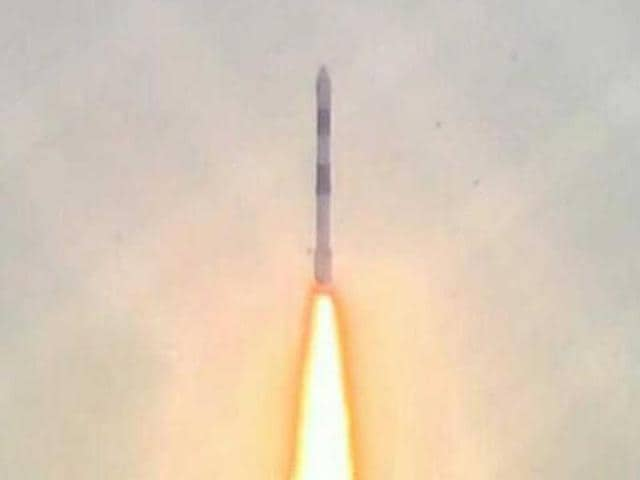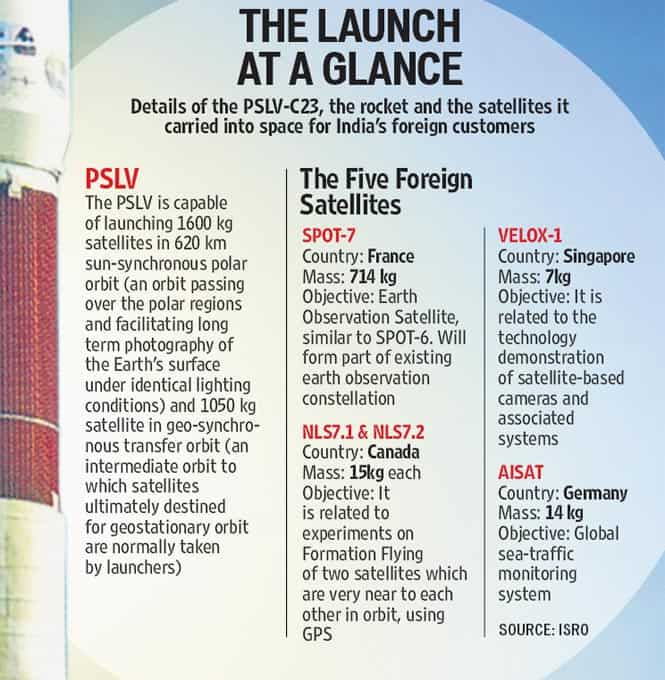India’s soaring space programme headed for the final frontier
The launch of five satellites last week confirmed that India’s space programme is soaring. HT looks at what the future holds, and at challenges that need to be overcome for its continued success.
On Monday, June 30, 2014, India launched five satellites: one each for Germany, and Singapore and two for Canada, which were co-passengers with the main load of SPOT-7, a French optical Earth Observation Satellite. After the high-profile launch of India’s Mars Orbiter Mission in November 2013, the launch of these satellites by the Indian Space Research Institute (ISRO) could have turned into a relatively low-key affair. But Prime Minister Narendra Modi chose the first space programme-related event since he assumed office to voice his thoughts on and plans for India’s space research programme. That all five satellites were foreign and had been launched by India under a commercial agreement also generated interest.

“India has been launching foreign satellites since 1999. Till January 2007, they were all co-passenger satellites, the main payload always being an Indian satellite. The first dedicated launch for a foreign satellite by PSLV (Polar Satellite Launch Vehicle) was that of an Italian satellite in April 2007,” explains an ISRO official. “This is the first time, however, that we have had a single exclusive commercial launch of so many foreign satellites. In the past we have launched 10 satellites at a time, eight of which have been foreign. But when it comes to the exclusive launch of foreign satellites, the maximum number we had launched at a single time, before June 30, had been two.”

At the Satish Dhawan Space Centre SHAR, Sriharikota, the Prime Minister displayed his familiarity with the highs and lows of India’s space odyssey and stressed that space research would form an important part of his plans for the country for the next five years. “India’s Space program is a perfect example of my vision of Scale, Speed and Skill,” he stated, urging that “continued progress in space must remain a national mission”.
But what prompts developed countries like Germany, France, Japan and UK — for we have launched satellites for all these countries — to approach India to launch satellites for them? Surely these countries have the technical know-how to do it themselves. As always, the answer has everything to do with economics.
“If the launcher is too big and you are using it to launch a small satellite, you will be underutilizing it. It may be more cost effective for the customer then to have a country like India launch it along with other smaller satellites,” an ISRO official explained. Representatives of both ISRO and Antrix Corporation Ltd, which handles its marketing and commercial aspects and negotiates with potential customers, declined to disclose how cost effective it is for customer countries to have a satellite launched in and by India. “We sign individual contracts with each customer and the terms of the contract are confidential,” said a source in Antrix. According to data available on the company portal, Antrix’s total income in the financial year ending in March 2010 was Rs. 88,392.16 lakhs before taxes. The profit after tax for the same year was Rs. 12,802.80 lakhs. Apart from satellite launches, the company also offers services like mission support, ground systems, spacecraft testing and training and consultancy. While Antrix handles the commercial aspects, ISRO executes the orders.
“Our primary objective is to launch our own satellites, but when we have the capability, why not use it for customers. It demonstrates India’s technological capability to the world,” the ISRO official said.
Clearly, as the PM himself suggested (“India’s advanced Space Programme puts her in an elite global group of five to six countries today.”), the nation has reached a significant point in its space odyssey, one that began in the early 1960s and initially involved, as Henri Cartier Bresson’s historic pictures show, energetically flogging the Indian talent for jugaad.
Part of the credit for the commercial success of the country’s space programme goes to India’s indigenous PSLV, that acted as the launch vehicle for the satellites on June 30. Incidentally, it was the PSLV’s twenty-seventh flight and twenty sixth successful flight in a row. “The capabilities of the PSLV have been continuously enhanced. It is a versatile vehicle that has put satellites in various orbits and has carved a niche for itself when it comes to launching satellites that weigh between 300 and 700kg,” the ISRO official said adding that as a result, India has made a name for itself in launching small, micro and nano satellites. “Counting in Monday’s launch, it has launched 40 foreign satellites till date,” he said.
However, there’s still a long way to go. India is still not completely capable of handling all its space projects on its own. “At present we do not have the capability to launch satellites that weigh more than 2000 kgs. Such big satellites are mostly communication satellites. Last year, we paid a fee to have two such big satellites launched by Arianespace of Europe on a commercial basis,” the ISRO official said.
A news report published in January this year quoted ISRO chairman Dr K Radhakrishnan as saying the country pays around $85-90 million, roughly Rs 500 crore, as launch fee for sending up a 3.5 tonne communication satellite. “The GSLV (Geosynchronous Satellite Launch Vehicle) rocket costs around `220 crore and the GSAT-14 satellite launched in January, 2014 costs around `145 crore,” he had added. India is scheduled to test its latest fifth generation rocket, the GSLV Mark III soon. “The present GSLV is capable of launching satellites weighing up to two tonnes towards a geosynchronised orbit. The new one will have the capability to launch satellites twice that size. It will be more powerful, massive and more efficient,” said an ISRO official.
It is in this scenario that the PM’s exhortation to scientists to “extend our launching capabilities to heavier satellites” takes on some significance. Money, as always, may be a challenge. “ISRO’s annual budget is just over one billion dollars. NASA alone spends 17-18 billion dollars annually on space research and programmes,” pointed out a source in ISRO.
Still, there is no denying Indian ingenuity, and the PM too referred to the country’s propensity for “frugal engineering, and the power of imagination”. “I have heard that our Mars Mission cost less than the Hollywood movie Gravity,” he stated. However, if India’s space programme needs to take off in a more spectacular way, some fundamental changes might be necessary. For starters, the money earned from commercial launches should strictly be channelled back into space study. Right now, according to a source, “The earnings belong to the Government of India and may be used as it sees fit”.
The PM has made it clear that he intends to throw his weight behind the country’s space research programme. “I urge the Department of Space to proactively engage with all stakeholders, to maximize the use of space science in governance and development. Deepening of state involvement will be critical for the same,” he said. In his enthusiasm to build on the country’s relationships with its neighbours, the PM also urged scientists to build a SAARC satellite “that provides a full range of applications and services to all our neighbours”. He linked India’s first moon mission, Chandrayaan I, to former PM Atal Bihari Vajpayee’s vision and spoke of his own interest in the Mars Mission that had been launched under the UPA government.
The new government can do much for the country’s dreams to foray further into space. Both, the Space Commission which formulates the country’s space policies and the Department of Space that implements it through ISRO and other agencies are under the Prime Minister. This could simultaneously be a blessing and a curse. In their desire to win popular approval, a government could affect ISRO’s research and perhaps even change its focus. ISRO officials insist such things are unheard of. “Change in government does not impact us. No Prime Minister or government has interfered in our work ever,” said an ISRO official.
If anything dampened the spirits at Sriharikota, it was that officials at ISRO and Antrix shied away from making any official statements. In a departure from the norm, no press briefing followed the launch either. Still, in the end, the event turned out to be a success for the country’s space programme and for the new PM.
Projects to look forward to
Mars Orbiter Mission: Expected to reach Mars orbit on September 24, 2014. “The main aim of the Mars Orbiter Mission was to demonstrate India’s capability to successfully build and launch a mission to Mars. It will carry various equipment for research such as a colour camera to study the surface of the planet, a thermal infrared imaging spectrameter for the study of the minerals there, and a methane sensor to study whether the minute amounts of methane present in the atmosphere have a biological or geological source. If the methane was produced by biological activities, it would hint at the possibility of life on Mars. The mission will also study how water was lost from the surface of the planet and look at its outer atmosphere and space.
GSLV Mark III: Designed to launch heavier communication satellites weighing 4500 to 5000 kg, it would also enhance the capability of the country to be a competitive player in the multimillion dollar commercial launch market. GSLV is designed to put satellites to geosynchronous transfer orbit, an intermediate orbit to which satellites ultimately destined for geostationary orbit are normally taken by launchers. GSLV-MK III is designed to be a two-stage vehicle with strap-ons, and will be 42.4 m tall with a lift off weight of 630 tonnes.
Chandrayaan II: While the Chandrayaan I was designed to circle the moon and impacted a probe on its surface, India’s second moon mission, Chandrayaan II, set to be launched in 2016-17, will have a soft land rover – a wheeled robotic vehicle to explore the landing area, said an ISRO official.
Manned mission to space: 30 years after Indian astronoaut Rakesh Sharma travel in space as part of a mission partnered with the Soviet Union, India is working on its first independent crewed space mission. “A project report has been prepared, but we are yet to get government approval,” said a source in ISRO.







